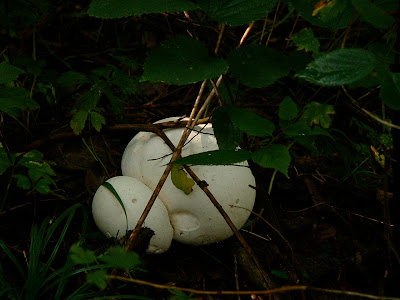On Saturday, September 22 at about 9 o'clock in the morning local time, Old Sol crossed the celestial equator, marking the autumnal equinox ("equal night"), although not until Tuesday the 25th were day and night closest to equal length at our northerly latitude. Nevertheless, it being a matter only of minutes in difference, I chose the 22nd to set sunrise and sunset stakes on the perimeter of the observatory in the big terraced field. The stakes will be replaced by something when we eventually build our version of Stonehenge.
In this predawn image you can see the guywire-supported gnomon ("indicator", "that which discerns") in the center of the field that we use to line up the stakes with the rising and setting sun on significant dates.
Here it comes.
I set the stake and quickly walked down to the road, which runs east-west. At the equinox, the sun rises precisely in the east and sets precisely in the west.
I am a gnomon.
In the evening I was back out with my sunset stake. The fall colors are coming on in the avenue of ornamental maples and Grandmother Cottonwood.
And there it goes. The observatory gnomon is barely discernable in this image.
As the earth rolled up in front of the solar disk, the clouds were illuminated from beneath.
When the drought broke in August, the garden responded with a burst of productivity in a race against time as the first frosts approached. Saturday and Sunday night there were spots of frost that knocked down the peppers, the tomatoes, and the sweet potatoes so the following days I hurried to harvest them.
Here are the last of the peppers.
Last night I made a first batch of pickled jalapenos – five-eighths of a peck of pickled peppers.
Sweet potatoes have to be cured for long-term storage, a week to ten days at about 85 degrees and 85 percent humidity. I'm doing this in the oven with a pan of water below and the oven light as the heat source.
In the garage I'm drying mustard and sunflowers for the seed.
I took my early morning walk today around the farm perimeter, hoping to observe a coyote, and I was not disappointed but still pleasantly surprised. Across the north fence where Kincaid Creek passes onto our place were three of these handsome creatures, about 50 yards distant. They noticed me but did not startle and I watched for about ten minutes until they trotted off into the woods. A most excellent beginning to the day.

















































